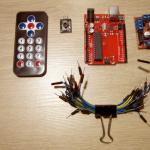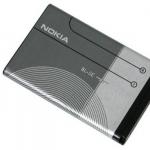What is useful to know about batteries for mobile phones. Batteries in smartphones: main types, their pros and cons Design features of batteries for mobile phones
The battery is an integral part of a mobile phone, which ensures its autonomous operation. How often you need to use the charger will depend on the correct use of the battery, as well as the capabilities of your phone.
Types of batteries
There are three main types of batteries used in mobile phones: nickel-cadmium, lithium-ion and lithium-polymer. In fact, there are more of them, but the remaining species have not become widespread, so we will leave them outside the scope of this article.
Nickel-cadmium batteries were once very popular, but today they are almost abandoned due to their harmful effects on the environment and a number of other disadvantages. Modern mobile phones do not use them, unless you find such a battery in some very old model. At one time, their widespread distribution was due to their low cost, but otherwise they had a number of negative qualities: rapid self-discharge, low capacity-to-physical size ratio, and strong heating during operation. Nickel-cadmium batteries have a so-called “memory effect”, due to which they have to be regularly charged and completely discharged several cycles in a row. This effect manifests itself when they begin to recharge a battery that has not yet been completely drained. This leaves a charge that cannot be used, and as a result, the battery life of the device is reduced. On average, nickel-cadmium batteries require more than 1000 charge-discharge cycles.
Lithium-ion batteries are the most widely used in modern mobile devices. They are more durable and less harmful to the environment than nickel-cadmium, and at the same time have a much higher energy density: despite their modest physical dimensions, they have a relatively high capacity. They do not have a “memory effect” and are characterized by a low self-discharge rate. The disadvantages of this type of battery include aging (even if they are not used for their intended purpose), so it is not recommended to buy them for future use. Better yet, pay attention to the production date when purchasing a new lithium-ion battery. This type of battery does not require any special maintenance, but if properly stored (in a charged state) and operated within the temperature range, it will last much longer. On average, lithium-ion batteries typically last from 500 to 1000 charge-discharge cycles.

Lithium polymer batteries are an improvement on lithium-ion batteries, but are cheaper. They are characterized by high energy density, slow self-discharge, and are even more environmentally friendly. Like lithium-ion batteries, they tend to age gradually. On average, lithium-polymer batteries have 500 to 600 charge-discharge cycles.
Features of battery operation
The following reasons can shorten the life of most batteries or completely render them unusable:
- non-compliance with operating rules (hypothermia, overheating, moisture ingress);
- physical damage to the contact group;
- opening the battery yourself at home;
- frequent falls and blows;
- recharging the battery with the phone turned on;
- replacing the battery with the phone on;
- regular long-term recharging (more than a day when switched on);
- long-term storage without use.

Any of the three types of batteries considered loses its capacity over time and must be replaced after 2-3 years of constant use. This is a normal process - there is no point in scolding manufacturers for a low-quality product, which often lasts much less than the mobile phone itself. If there is a need for replacement, you should choose more expensive branded batteries rather than cheap counterfeits, since the savings in this case can be very dubious.
You should also be aware that the battery life of your device can be significantly affected by the location of the mobile operator's base stations. The further away the station, the more energy is required to receive the signal and the faster the battery will need to be recharged.
Selecting a phone depending on battery capacity
Today you can find phones on sale that are equipped with batteries with a capacity of 800 to 1500 mAh. There are phone models with battery capacities outside this range, but they are rather the exception to the rule.
When buying a phone and preliminary calculating its battery life, you should correctly evaluate the capabilities of the mobile device as a whole. The fact is that not every phone or smartphone with a battery capacity of 1300-1500 mAh will work for weeks on end, everything can be just the opposite. The manufacturer usually indicates in the device specifications not only the battery capacity, but also the battery life during continuous phone calls and in standby mode. In the first case it is usually 5-8 hours, in the second - about two weeks. But these are dry numbers for extreme cases - in fact, we understand that no one will talk for hours or just look at the phone day and night. Therefore, the actual operating time of the phone will depend on its technical characteristics and battery capacity, and not on any one factor.

Typically, the simpler the phone, the longer it can work without recharging. The main part of “long-lasting” phones are typical all-in-one devices that have a very ordinary screen up to 2 inches diagonal and do not imply the constant use of wireless communications (Bluetooth, Wi-Fi, GPS modules, etc.). The battery capacity for most of these devices is small (up to 1000 mAh), but the absence of energy-intensive functions and modules under moderate load allows you to recharge it approximately once every 5-7 days. By moderate load we mean daily calls for 30-50 minutes, 2-3 sent/received messages, 1-2 pictures taken with the camera, about half an hour of working with additional applications (browser, organizer, audio player).
Today, mobile phones and smartphones with touch screens are very popular. They are modern and convenient, but cannot work for a long time without recharging. Large touch screens (and most often they have 3-4 inches diagonally) are very energy-intensive, and the hardware platform (if we are talking about a smartphone) places a significant load. In addition, touchphones are most often used for checking email, getting directions, transferring data, viewing multimedia content - all these features additionally “eat up” a fair share of battery capacity. With rare exceptions, the operating schedule for smartphones with touch screens is as follows: work during the day, recharge in the evening.
Cell phones become obsolete very quickly (probably even faster than computers), and it often turns out that replacing an old battery in a phone is problematic. They are simply not produced, and therefore high-quality batteries are not on sale (Chinese handicrafts in homemade plastic bags do not count - there is no point in buying them, they usually do not hold a charge for a long time). It's a shame to throw away a perfectly good phone that you're very used to.
If you know how to hold a soldering iron in your hands a little, you can simply solve this problem. This is possible because the energy carrier in all mobile phone batteries is the same technology - it is almost always Li-Ion(lithium ion) or Li-Polymer(lithium polymer) cell with a voltage of 3.6 — 3.7 Volt. The only difference is in the dimensions of the battery, the location and number of contacts on it. You buy any (I emphasize ANY) battery from another modern phone, approximately suitable in size, and then you just need to pull out the energy carrier from there and transfer it to the body of the old battery. Further, for simplicity, I will call the assembly of the case, controller and electrical element a “battery” or “battery”, and the electrical element inside the battery – “energy carrier”, or “element”, or “can”. The battery was replaced for a Siemens ME45 phone.
So, the process of restoring an old battery consists of several simple steps:
Step 1. Open the phone, take out the old battery, determine its type and capacity. For my Siemens ME45 it was a Li-Ion battery with a capacity of 840 mAh, a voltage of 3.7 volts, see photo.

The most important thing is to determine battery type(Li-Ion or Li-Polymer). The fact is that the charging mode and the design of the battery controller (a special electronic circuit that ensures the correct charge) depend on this. Li-Polymer batteries are afraid of overcharging, so I would not advise you to replace the Li-Ion element in an old battery with Li-Polymer.
Note. In terms of voltage, Li-Ion and Li-Polymer are almost the same. Li-Polymer has lower internal resistance and higher energy capacity than Li-Ion with the same size and weight, so Li-Polymer batteries are used in aircraft modeling to power power plants. The disadvantage of Li-Polymer is that it is afraid of overcharging (it swells and can explode). Never leave a charging Li-Polymer battery unattended, and use only chargers specifically designed for Li-Polymer to charge it!
Step 2. Now it’s worth disassembling the old battery and familiarizing yourself with the contents. The filling is not very complicated - the case contains a controller (a small scarf) and an energy carrier - a weighty rectangle with two contacts. The controller contacts go outside, and an energy carrier is connected to it inside.

The controller board is visible from below, and the external battery contacts are in the background, in this photo at the bottom left.

The energy carrier is raised, the back of the external contacts is visible, as well as the “-“ bus (to the left, in the center) and the “+“ energy carrier bus (to the right), soldered to the controller.

This is a top view of the controller. The power buses from the element are soldered on this side (in the photo it is already sealed off). Big eight-legged chip 9926A is a field-effect transistor that serves as a key, and a small 6-legged little thing 521A most likely a specialized chip (I was unable to find its description) that measures the voltage of the element and determines the logic of the controller (controls the field-effect transistor and the process of charging the element).

View of the controller board from the “bottom”; external contacts are soldered on this side.
Step 3. Go to the store, show the seller your old battery and ask to sell the same one. The seller, of course, says that sorry, there are no such batteries. Then you ask him to show all the battery models he has, and select the one that matches the type (for example, if your old battery was Li-Ion, then you need to look for a Li-Ion battery too) and has a capacity that suits you ( measured in milliamps/hours). The larger the capacity, the better. With voltage everything is simpler, you can’t go wrong here - all batteries have one jar inside with a voltage of 3.6 .. 3.7 volts. Also pay attention to the quality of packaging and the release time of the battery; the fresher the battery, the better - it will last longer.
Change only Li-Ion to Li-Ion and Li-Polymer to Li-Polymer! Step 4 . Carefully disassemble the new battery and separate the element from the controller. If possible, try to unsolder it - this will make it easier to connect the element to the old controller. I couldn’t unsolder it (the joint was filled with compound), and I just had to tear it off. After this procedure, two contacts should stick out from the element - plus and minus, which must be tinned and then soldered to the old controller.
Attention! Do not reverse the polarity and do not accidentally short-circuit the element contacts during soldering. At this step I had to face a small problem - the positive contact of the element was made of aluminum and flatly refused to be serviced. In addition, it was very delicate (essentially thick foil) and could come off with any careless movement. I had to figure out how to make a reliable contact for him. The old socket came to the rescue DIP

microcircuits - 2 contacts from it were just suitable for this purpose. They were springy and connected well to the element contact, see photos.


The energy carrier is visible here; the controller has already been torn off from it. On the left is a negative contact; we managed to irradiate it. On the right is a positive aluminum contact and contacts from the socket, prepared for connection. In order for the cell to fit into the battery case, I had to slightly squeeze it on the sides. This operation must be done very carefully - under no circumstances should you break the seal of the battery (especially for Li-Polymer).

The socket contacts are mounted on the element contact.

Almost finished battery. Soft blue spacers (I took shock-absorbing washers from an old CD-ROM) are needed to ensure that the element does not dangle in the battery case. All you have to do is close the lid and the process is complete. I did not glue the lid, but simply wrapped it with 2 layers of tape.
"Old guy" with a new battery - everything is in order!

This is all that remains of the “donor” - a label and a broken controller.
Articles and Lifehacks
Content:1.
2.
3.
4.
5.
6.
Year after year, batteries in smartphones become more and more advanced: their capacity increases, weight and dimensions decrease, and disadvantages disappear.
Don’t forget about environmental safety, because this part is considered the most “dirty” in modern gadgets.
Let's see what kind of “batteries” can be found in mobile devices today.
Main types of batteries
Throughout the history of cell phone development, they have used four types of batteries:- nickel-cadmium;
- nickel-metal hybrid;
- lithium-ion;
- lithium polymer.
This type of power supply comes from the pre-mobile era. The first samples have been known since the end of the 19th century. Until the end of the last century, industrialists made numerous attempts to get rid of their inherent shortcomings, and to some extent they succeeded.
One way or another, the developers of the first mobile devices simply did not have much choice. Basic the complaints were as follows:
- the use of toxic metals harmful to human health in the design;
- insufficient battery capacity;
- limited number of charge/discharge cycles;
- low technology in production, leading to increased costs;
- the so-called “memory effect”.
Such power supplies also had advantages - a wide range of operating temperatures. However, there were significantly more disadvantages, and in an attempt to cope with them, the following type of battery was created.

They did not contain toxic cadmium, the mere mention of which causes hysterics among particularly impressionable environmentalists. In addition, the memory effect was much weaker.
The capacity has also increased, and the cost, on the contrary, has decreased slightly. But they were compared to NiCd batteries and serious shortcomings:
- the need to use a complex charger;
- reducing the number of charge/discharge cycles.

This type of battery has caused a real revolution in the world of gadgets.
From now on, the duration of their work in standby mode has increased significantly. The annoying memory effect has also disappeared, although some particularly advanced users continue to “train” the batteries of their devices out of old memory.
Most smartphone models on the market today are equipped with this type of battery.
But they also have disadvantages, and quite unpleasant ones.:
- Narrow operating temperature range.
- Potential danger of battery destruction due to deep discharge or overcharging.
- Rapid “aging”, which after 2-3 years disables the battery.
- Quite a high cost.
First of all, they were not satisfied with the relatively high cost, so another type of battery was created.

In them, the explosive electrolyte gave way to a polymer mass. The price of such power supplies has decreased slightly, mainly due to the need to use more complex protective circuits. The power hasn't increased much either.
But the good thing about solid polymer is that it frees up the hands of designers, allowing them to choose the shape and size of the element at their own discretion. Around this time, many ultra-thin smartphone models with non-removable batteries appeared.
Both types of lithium batteries have a common drawback: regardless of the intensity of use and the number of charge/discharge cycles, their capacity gradually decreases. And after a couple of years, the gadget can be thrown away with a clear conscience. Or, say, hang it on the wall as an exotic decoration.
It is believed that the lithium-polymer type is slightly less “tenacious”, but this information is from the category of myths; there are examples that both confirm and refute this statement. So it is certainly not possible to distinguish truth from fiction.
Fast charging technology

You can often hear from sellers offering to buy a smartphone about a certain battery with a fast charging function. Particularly advanced ones also frighten buyers with the impressive-sounding Qualcomm Quick Charge, and the most experienced ones also add version 2.0 or 3.0. What kind of miracle batteries are these?
In reality, this technology has nothing to do with the type of power source. It just allows you to use increased amperage, which reduces charging time significantly.
And to ensure that destructive overcharging does not occur and charging is carried out correctly, the chipset monitors, in which, in fact, this technology is implemented. To date, it has been perfectly developed, and there is no threat to the gadget when using it.
To sum up, we can say: The main types of batteries in smartphones today are lithium-ion (Li-Ion) and lithium polymer (Li-Pol). In mobile device models, you can find both of them, and there is no alternative to them in the foreseeable future.
But the massive introduction of such batteries has turned lithium into a strategically important element, and countries with deposits of minerals containing it have turned into objects of commercial (and other) interest of transnational capital.
Gone are the days when batteries for cell phones were assembled in the same way as car batteries, only in miniature. Only 20 years ago, a cell phone battery was made of parts that seemed to replicate the entire complex of devices of a larger brother. The figure shows a cross-section of one of these elements.
Science and practice jointly promote technological progress. In 1991, lithium-ion batteries appeared, in which the cathode material of the electrodes is applied to aluminum foil, and the anode material is applied to copper.
Lithium ions, under the influence of electric current, are introduced into the crystal lattice of graphite and form chemical bonds with carbon molecules. When these bonds are broken, energy is released, which is converted into electric current at the battery poles.
In recent years, lithium polymer batteries have emerged.
The diagram shows how simply such a battery for a cell phone is designed.
Phone battery banks
Battery cans are soft plastic bags filled with a solution of lithium in a polymer, similar in consistency to sour cream. To monitor the battery condition, a controller is connected to the banks. It is designed as an electronic board and can restrict the connection of a charger that does not meet the parameters, and the cell phone battery will not charge, no matter how hard we try. Instead of the usual 2 contacts to connect to the cell phone board, the battery device uses a connector - a multi-pole connection.
How does a phone battery work and how does it work?
The process of storing and releasing energy from such DC sources is similar to lithium-ion batteries, but their production is much cheaper, although in some characteristics they are inferior to their predecessors.
The basic safety precautions to take when using small phone batteries are no different from the operating safety precautions for acidic or alkaline DC power supplies found in automobiles. Charging with increased voltage leading to overheating or short circuiting the battery cells can lead to a fire. And as you know, a small spark ignites a big flame.
That is why each battery has a battery controller that turns off charging when a certain value is reached and turns off the phone when the discharge reaches a critical point.
Batteries for mobile devices
Device and main parameters
Cell phones and laptop computers, radio stations and cordless phones, uninterruptible power supplies, movie cameras and cameras, powerful hand tools, medical devices, various production equipment - this is not a complete list of devices, the normal operation of which directly depends on the condition of the batteries. In this regard, knowledge of the characteristics, features and operating conditions of various types of batteries is of particular importance and is the key to trouble-free operation of mobile devices and portable equipment.
If you are curious and have some skills in damaging toys acquired as a child, then you are probably already familiar with the internal structure of your used battery. What's inside? (I do not recommend disassembling, this is associated with the risk of physical damage). Actually nothing special. Round or prismatic “batteries”, of which you can find them in bulk at the nearest store, and at a much lower price. However, first impressions are deceiving. In front of you are not just batteries, but accumulators. And they differ from batteries in that they allow (due to the reversibility of the reactions occurring in them) multiple discharge-charge cycles. This is their advantage over batteries, but on the other hand, this is the “headache” that they bring in case of loss of performance. And if with the first ones everything is simple: bought it, inserted it, ran out, threw it away and bought new ones, then with batteries the situation is more complicated. For them, the sequence of actions is different: bought; prepared for work; use in compliance with the operating instructions; and only when it’s completely unbearable, you buy a new one.
So, so as not to be excruciatingly painful for wasted money, below is information for the curious and inquisitive on the topic: what you need to know about batteries for mobile phones and laptop computers.
Device
Any battery, as a rule, consists of several single cells connected in series to increase the generated voltage and packaged in a common housing. The design of a single battery cell, for example nickel-metal hydride, with the electrochemical reactions taking place inside it, and other useful information (in English) can be found on the Panasonic website by downloading the file in pdf format Overview information on NiMH Batteries in PDF Format - 137KB .
In addition to single cells, nickel-based batteries contain a thermal fuse and a temperature sensor inside (the latter may not be present in NiCd batteries). The thermal fuse ensures safety at high charging currents, and the output signal of the temperature sensor is processed by the charger. Depending on the temperature value, a “competent” charger provides different battery charging modes: fast, slow, and switching from one to another.
In addition to a thermal fuse and temperature sensor, lithium-ion batteries contain a special control integrated circuit and control keys. All this together is designed to protect the consumer from physical damage in the event of a violation of the electrical operating conditions of the battery.
BASIC PARAMETERS OF BATTERIES
Let it be known to you that a battery, as an electrical device, is characterized by the following basic parameters: type of electrochemical system, voltage, electrical capacity, internal resistance, self-discharge current and service life. Moreover, depending on the scope of application, some parameters come to the fore, then others. For example, a battery for cell phones should be assessed based on the totality of the values of its three main characteristics: real capacity, internal resistance and self-discharge current, while a battery for a home radiotelephone with a range of up to 100 meters needs to be assessed only by capacity and self-discharge. If you underestimate or ignore any parameter or exaggerate the importance of one of them (usually capacity), you can find yourself in a “broken trough” situation.
Voltage. The battery voltage is determined by the device it is intended to power. If the required voltage value is not provided by one element, then the battery is assembled from several elements connected in series. For example, cell phones of various models use batteries with a voltage of 3.6 V (1 Li-ion cell or 3 NiCd or 3 NiMH cells), 4.8 V (only 3 NiCd or 3 NiMH cells), 6 V (only 5 NiCd or 5 NiMH cells), 7.2 V (2 Li-ion cells). Thus, if the phone uses 4 NiMH batteries with a total voltage of 4.8 V (as, for example, in some of the latest Ericsson models), then the use of Li-ion batteries in it is impossible. The battery voltage is not constant during operation. It is maximum immediately after the end of charging, and then decreases during operation or storage. Eventually, it decreases to such an extent that the cell phone does not turn on or turns off automatically. When assessing the condition of a battery, its voltage must be measured under the load for which it is designed.
Electrical capacity. Rated electrical capacity is the amount of energy that a battery should theoretically have when charged. This parameter is similar to the capacity of a vessel, for example, a glass. So, 200 ml of water (up to the rim) can be poured into a standard faceted glass; only a certain amount of energy can be pumped into a specific battery. But this amount of energy (capacity) is determined not at the moment of pumping (filling), but during the reverse process - discharging (pouring energy) of the battery with direct current during a measured period of time until the specified threshold voltage is reached. Capacity is measured in ampere-hours (Ah) or milliampere-hours (mAh) respectively and is designated by the letter “C”. The capacity value is indicated on the battery label or encrypted in its type designation. The actual capacity of a new battery at the time of its commissioning ranges from 80 to 110% of the nominal value and depends on the manufacturer, storage conditions and period, and commissioning technology. Theoretically, a battery with a nominal capacity of 1000 mAh, for example, can deliver a current of 1000 mA for one hour, 100 mA for 10 hours, or 10 mA for 100 hours. In practice, at a high value of the discharge current, the rated capacity is not achieved, and at a low current, it is exceeded.
During operation, the battery capacity decreases. The rate of reduction depends on the type of electrochemical system, maintenance technology during operation, chargers used, operating conditions and period of use. Using the same analogy with a glass, we can say that the amount of water poured into a glass will decrease if you pour water with a large amount of mechanical impurities and drain it if it has settled. Then sediment will gradually accumulate in the glass, reducing its usable capacity. In a battery, a similar “precipitate” forms during charge/discharge cycles.
Internal resistance. The battery's internal resistance (current source resistance) determines its ability to deliver high current to the load. This dependence obeys Ohm's law (remember your school physics course). With a low value of internal resistance, the battery is able to deliver a higher peak current to the load (without significantly reducing the voltage at its terminals), and therefore greater peak power. While a high resistance value leads to a sharp decrease in voltage at the battery terminals with a sharp increase in load current. Such a collapse (decrease) in voltage characterizes the “weakness” of an apparently good battery, because the stored energy cannot be fully supplied to the load.
In other words, everything said above about the internal resistance of a battery can be illustrated as follows. Let's imagine that you need to water your garden plot within an hour from a tank (battery) that you previously filled with water. In the normal state of affairs, you connect a hose to the drain tap, open the tap completely and water the area for an hour until the water in the tank runs out. Now let’s assume that the drain valve at your tank is jammed, you can only open it a little and water flows out of it only in a thin stream. It seems that there is water in the tank (the battery is charged), but it is impossible to water normally. The tap in this case plays the role of internal resistance for the tank. If the stream from the tap is large, then the internal resistance of the tank is small, if it is small, then the internal resistance of the tank is large.
What do we have practically? A cell phone in standby mode consumes a small amount of current from the battery, and the capacity of the tap of its battery is quite enough to power the phone. As soon as an incoming call comes in or you start making an outgoing call, the phone requires tens of times more energy to operate normally in transmission mode, so the tap's throughput needs to be increased. If the faucet is normal, then it will allow this increased flow of energy through itself; if it is jammed, then it is not, and the phone turns off. This is especially typical for cell phones of NMT, AMPS standards, trunk and conventional radio stations, and laptop computers.
The internal resistance of a battery depends on the type of its electrochemical system, capacity, number of cells in the battery connected in series, and increases towards the end of its service life.
Self-discharge. The phenomenon of self-discharge is, to a greater or lesser extent, characteristic of all types of batteries and consists in their loss of their capacity after they have been fully charged. To quantify self-discharge, it is convenient to use the amount of capacity lost over a certain time, expressed as a percentage of the value obtained immediately after charging. A period of time, as a rule, is taken to be a time interval equal to one day and one month. So, for example, for serviceable NiCd batteries, self-discharge of up to 10% is considered acceptable during the first 24 hours after the end of charging, for NiMH - a little more, and for Li-ion it is negligible and is estimated per month. It should be noted that self-discharge of batteries is maximum in the first 24 hours after charging, and then decreases significantly.
The self-discharge of batteries depends on the quality of the materials used, the manufacturing process, the type and design of the battery. It increases sharply when the ambient temperature rises, the internal battery separator is damaged due to improper maintenance and due to the aging process.
Battery life (life). It is usually assessed by the number of charge/discharge cycles that the battery can withstand during operation without significant deterioration in its main parameters: capacity, self-discharge and internal resistance. Service life depends on many factors: charging methods, depth of discharge, maintenance procedures or lack thereof, temperature and the electrochemical nature of the battery. In addition, it is determined by the time that has passed since the date of manufacture, especially for Li-ion batteries. A battery is generally considered to have failed once its capacity has dropped below 80% of its rated value.
For a more detailed and professional introduction to batteries, we can recommend the Panasonic website, which contains detailed reference data and analytical materials about NiCd, NiMH, Li-ion batteries produced by this company (in English). Unfortunately, the company did not give permission to translate and publish this information in Russian, citing the lack of its representation in Russia in this area and the impossibility of assessing the translated materials. But the information posted there is of some interest to both developers of battery-powered equipment and users, so below is a short list of issues covered there:
- appearance;
- internal organization;
- electrochemical reactions occurring inside the battery;
- peculiarities;
- five main characteristics: charging, discharging, number of charge/discharge cycles, storage (self-discharge), safety with graphs and explanations;
- charging methods;
- packing cells into batteries;
- precautions when designing devices with batteries.
When writing this article, materials were used kindly provided by Mr. Isidor Buchmann, founder and head of the Canadian company Cadex Electronics Inc. .
More detailed information in Russian about batteries for mobile communications equipment, computers and other portable devices, tips for operation and maintenance are given in
LINKS
- Cadex Electronics Inc. , Vancouver, BC, Canada - designer and manufacturer of chargers, analyzers and battery maintenance systems (in English).
- Batteries for mobile devices and laptop computers. Battery analyzers (in Russian).
- , manufactured by Panasonic (in English).





